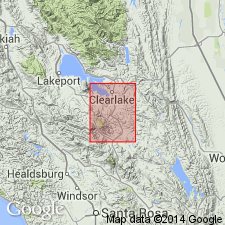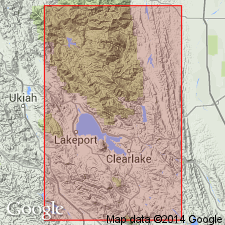
- Usage in publication:
-
- Clear Lake volcanic series
- Modifications:
-
- Named
- Dominant lithology:
-
- Tuff
- Basalt
- Dacite
- Obsidian
- AAPG geologic province:
-
- California Coast Ranges province
Summary:
Clear Lake Volcanic Series named for volcanic rocks in Clear Lake area, Lower Lake 15' quad, Lake Co, CA. Rocks described and mapped by Anderson (1936). Shown on columnar section as comprising (ascending): rhyolite tuff, olivine basalt, Perini Hills flows, Boggs Mountain flows, Cobb Mountain volcanics (new), pyroxene dacite, obsidian, and Konocti volcanics (new). Age relations of individual units are imperfectly known because some units are isolated and contacts of contiguous flows are commonly obscured by sliding. Rhyolitic tuffs and olivine basalt are in part intercalated with Cache formation (new). Is apparently younger than Sonoma volcanics of middle or late Pliocene age. Age given as late Pliocene, Pleistocene, and Recent [Holocene].
Source: GNU records (USGS DDS-6; Menlo GNULEX).

- Usage in publication:
-
- Clear Lake Volcanics*
- Modifications:
-
- Adopted
- Revised
- Age modified
- Geochronologic dating
- AAPG geologic province:
-
- California Coast Ranges province
Summary:
Clear Lake Volcanic Series of Brice [1953] is adopted as Clear Lake Volcanics. Covers area of 400 sq km about 150 km north of San Francisco in the Coast Ranges. Consists of basalt, andesite, dacite, and rhyolite which occur as domes, flows, pyroclastic deposits in structurally and chronologically complex sequence. Overlies rocks of Franciscan assemblage and Great Valley sequence. K-Ar ages range from about 2.5 Ma to 0.03 Ma or less. Age is late Pliocene(?) to Holocene.
Source: GNU records (USGS DDS-6; Menlo GNULEX).
- Usage in publication:
-
- Clear Lake Volcanics*
- Modifications:
-
- Geochronologic dating
- Age modified
- AAPG geologic province:
-
- California Coast Ranges province
Summary:
Age of Clear Lake Volcanics is late Pliocene to Holocene on basis of K-Ar age of 2.1 Ma and later ages.
Source: GNU records (USGS DDS-6; Menlo GNULEX).
For more information, please contact Nancy Stamm, Geologic Names Committee Secretary.
Asterisk (*) indicates published by U.S. Geological Survey authors.
"No current usage" (†) implies that a name has been abandoned or has fallen into disuse. Former usage and, if known, replacement name given in parentheses ( ).
Slash (/) indicates name conflicts with nomenclatural guidelines (CSN, 1933; ACSN, 1961, 1970; NACSN, 1983, 2005, 2021). May be explained within brackets ([ ]).

